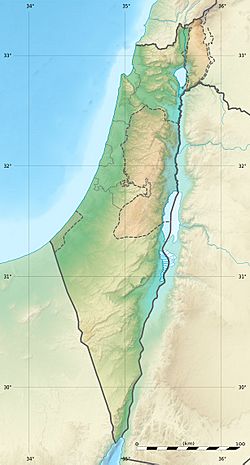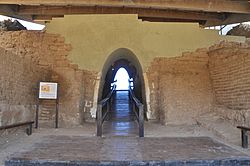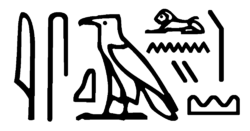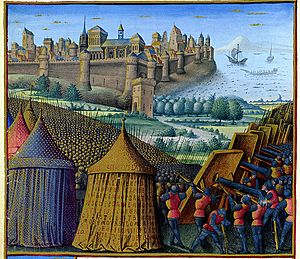Ascalon facts for kids
|
𐤀𐤔𐤒𐤋𐤍
אַשְׁקְלוֹן Ἀσκάλων عَسْقَلَان |
|
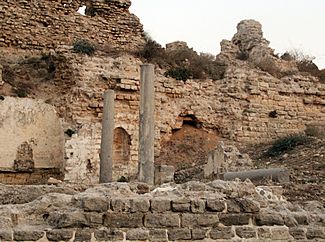
Remains of the Church of Santa Maria Viridis
|
|
| Location | Southern District, Israel |
|---|---|
| Region | Southern Levant, Middle East |
| Coordinates | 31°39′43″N 34°32′46″E / 31.66194°N 34.54611°E |
| Type | Settlement |
| History | |
| Founded | c. 2000 BC |
| Abandoned | 1270 AD |
| Periods | Bronze Age to Crusades |
| Cultures | Canaanite, Philistine, Phoenician, Crusaders |
| Site notes | |
| Excavation dates | 1815, 1920-1922, 1985-2016 |
| Archaeologists | Lady Hester Stanhope, John Garstang, W. J. Phythian-Adams, Lawrence Stager, Daniel Master |
Ascalon was an important port city on the Mediterranean coast. It is located in the southern Levant, a historical region in the Middle East. This ancient city has a rich history. It was once a major city of the Philistines. Later, it became a key stronghold during the Crusades, a series of religious wars.
Ascalon's importance faded after 1270 AD. The Mamluks, who were powerful rulers, destroyed its defenses and port. They did this to stop the Crusaders from using it for military purposes.
People lived in the Ascalon area as far back as 4,000 years ago. Strong city walls were built around 2000 BC. During the Late Bronze Age, Ascalon became part of the Egyptian Empire. After the arrival of the "Sea Peoples", it became one of the five main cities of the Philistines.
The city was later destroyed by the Babylonians. But it was rebuilt and remained a big city for many centuries. During the Crusades, it was a heavily fought-over fortress. Two big Crusader battles happened here: the Battle of Ascalon in 1099 and the Siege of Ascalon in 1153.
In 1270, the Mamluk sultan Baybars ordered the city's defenses and harbor to be destroyed. This was to prevent the Crusaders from using it again. Some buildings, like the Shrine of Husayn's Head, survived. A nearby town, al-Majdal, was built around the same time.
Later, a village called Al-Jura existed next to the old city walls. This village was abandoned in 1948. Today, the modern Israeli city of Ashkelon is named after this ancient site.
Contents
What's in a Name?
Ascalon has had many names over thousands of years. These names are all similar to each other. Experts think the name comes from an old word meaning "to weigh". This is also where the word "Shekel" comes from.
The city is first mentioned in ancient Egyptian texts from the 18th-19th centuries BC. It appears as Asqalānu. In letters from around 1350 BC, kings of Ašqaluna wrote to the Egyptian pharaoh. The Merneptah Stele (around 1208 BC) also mentions the pharaoh defeating a rebellion at Asqaluna.
The city is mentioned eleven times in the Hebrew Bible as ʾAšqəlōn. Later, the ancient Greeks called it Askálōn. This name was used during the Roman and Byzantine times too. In the early Islamic period, it was known as ʿAsqalān in Arabic. The Crusaders called it Ascalon. Today, in modern Hebrew, it is called Ashkelon. The ancient site is now a national park called Tel Ashkelon, meaning "Mound of Ascalon".
Where is Ascalon?
Ascalon is right on the Mediterranean coast. It is about 16 kilometers north of Gaza City and 14 kilometers south of Ashdod. Millions of years ago, a river flowed here. Over time, sand from the Nile Delta covered it, forming sandstone ridges. This river became an underground water source. The people of Ascalon used this water for their wells. The oldest well found there is from around 1000 BCE.
Life in Ancient Ascalon
Early Settlements
People lived in the Ascalon area very early on. Tools from about 23,000 to 10,000 BCE have been found. This shows that hunter-gatherers lived here. Later, around 7000–6400 BCE, people started settling down. Archaeologists found pits, hearths, and animal bones from this time.
During the Early Bronze Age I (3700–2900 BCE), a large settlement grew in Afridar, north of Tel Ashkelon. This area had good water, fertile soil, and many plants and animals. Trade with Prehistoric Egypt also helped it grow. This settlement was abandoned around 2900 BCE, possibly due to climate change.
From 2900–2500 BCE, Tel Ashkelon became an important seaport. It was a trade stop between Old Kingdom of Egypt and Byblos. A mudbrick building and many olive-oil jars were found here. This port was abandoned later in the 3rd millennium BC.
Canaanite City (1800 – 1170 BCE)
Ascalon was settled again in the Middle Bronze Age. This was a time when many cities in the region were growing. It became a fortified city-kingdom. Ancient Egyptian texts from the 20th–19th centuries BCE mention Ascalon. They list it as Asqanu and name some of its rulers. These rulers had names from a group of people called Amorites.
The most striking feature of Ascalon from this time is its strong defenses. These were huge earthen ramparts built around 1800 BCE. Archaeologists found five layers of construction in these defenses. They included city gates, moats, and guard towers.
Egyptian Rule (15th – 12th Century BCE)
Ascalon came under the control of New Kingdom of Egypt around 1457 BCE. This happened after the Battle of Megiddo. During this time, Ascalon's land stretched along the coast. It bordered Gaza to the south and Lachish to the east.
Letters from the 14th century BCE show Ascalon's ties to Egypt. These are called the Amarna letters. Rulers of Ascalon, like Yidya, wrote to the Egyptian pharaoh. They promised to provide food and supplies for Egyptian troops. One letter even asked Yidya to send glass.
The Merneptah Stele from around 1208 BCE mentions the pharaoh Merneptah defeating a rebellion. Ascalon was one of the cities that rebelled against him.
Philistine City (1170 – 604 BCE)
The Philistines settled in Ascalon around 1170 BCE. Their early pottery and buildings are similar to those found in ancient Greece. This supports the idea that they were part of the "Sea Peoples". These groups caused big changes across the Eastern Mediterranean at that time.
The Hebrew Bible describes Ascalon as one of the five main Philistine cities. These cities were often at war with the Israelites. An ancient Egyptian text from the 11th century BCE also lists Ascalon as a Philistine city.
In 2012, a Philistine cemetery was found outside the city. Over 200 graves were dug up. Some pottery pieces found had writing on them. This writing was similar to an ancient script from Cyprus.
Under Assyrian Rule (734 – around 620 BCE)
Around 734 BCE, the Neo-Assyrian Empire captured Ascalon. The city became a vassal kingdom, meaning it had to pay tribute to Assyria. King Mitinti I of Ascalon joined a revolt against Assyria. But the revolt failed, and he was killed. A new king, Rukibtu, took over and continued paying tribute.
Later, King Sidqa of Ascalon joined another rebellion. This time, he teamed up with King Hezekiah of Judah. The Assyrians attacked Ascalon and took control of its nearby cities. Sidqa was exiled, and a new king, Šarru-lu-dari, was put in charge.
Egyptian Influence and Babylonian Destruction (around 620 – 604 BCE)
Ascalon became very close to Egypt in the late 7th century BCE. Many Egyptian trade items and religious objects were found there. The Greek historian Herodotus wrote about Ascalon's temple of Aphrodite. He said it was very old and was robbed by Scythians.
By the end of the 7th century BCE, Ascalon had about 10,000–12,000 people. It had strong defenses with about 50 protective towers. The city produced and exported wine and olive oil. It also traded with many places, including Phoenicia and Greek regions.
The Philistine era in Ascalon ended in 604 BCE. The Babylonian king Nebuchadnezzar II destroyed the city. Its king, Aga', was sent into exile. Ascalon remained empty for 70 years after this destruction.
Persian and Greek Times (520 – 37 BCE)
Phoenician Settlement (520 – 290 BCE)
After the Babylonians, the Achaemenid Empire took over. Ascalon was rebuilt around 520–510 BCE by the Phoenicians, especially from the city of Tyre. Ancient texts from the 4th century BC call it "Ashkelon, the city of Tyre's people." Many Phoenician writings were found there.
Archaeologists found large buildings with stone foundations and mudbrick walls. The city had streets, workshops, and big warehouses near the shore. Many imported goods from the Mediterranean and Near East were found. These included luxury items like fancy pottery and a bronze statue of the Egyptian god Osiris. This shows Ascalon was a major seaport.
A unique discovery in Ascalon is a large dog cemetery. Over 800 dog burials were found, dating from the 5th to 4th centuries BCE. The dogs were buried carefully, suggesting they were sacred animals. Dogs were important in Phoenician society and religion.
The city was violently destroyed by fire around 290 BCE. This happened during the rule of Ptolemy I Soter, when the Ptolemaic Kingdom took control of the region.
Hellenistic Period (290 – 37 BCE)
During the 2nd and 1st centuries BCE, Ascalon had mostly good relations with the Hasmonean kingdom and the Herodian kingdom of Judea. There is a story that during the time of Queen Salome Alexandra, eighty women in Ascalon were accused of sorcery and sentenced to death.
Roman and Byzantine Times (37 BCE – 641 CE)
Roman Period
Herod the Great, a king who worked with the Roman Empire, built grand buildings in Ascalon. These included bath houses, fountains, and large columns. In 6 CE, Ascalon came directly under the rule of the Roman governor of Syria province.
The city's defenses from Roman and Islamic times followed the same path as the older Canaanite walls. They formed a large semicircle protecting the city from land. On the sea side, a high natural cliff protected it. Ascalon remained loyal to Rome during the Great Revolt (66–70 CE).
Byzantine Period
The city of Ascalon appears on a map from the 6th century called the Madaba Map. Several bishops of Ascalon are known from this period. For example, Sabinus attended the First Council of Nicaea in 325 CE.
Early Islamic Period (641 – 1099)
The Muslim conquest of Palestine began in 634. Ascalon was one of the last Byzantine cities in the region to fall. It surrendered to Mu'awiya I, who later started the Umayyad Caliphate, around 640. Mu'awiya made Ascalon a fortified military base.
During a Muslim civil war (680–692), the Byzantines briefly took back Ascalon. They destroyed the city and moved its people away. But the Umayyads regained control. Ascalon then had a time of growth after Abd al-Malik rebuilt and strengthened it. Even though its harbor wasn't the best, its location between Syria and Egypt helped it thrive. An Islamic scholar called it "the Bride of Syria."
From 712, Ascalon started making its own copper coins. These coins had the Arabic words "Struck in Filastin, Askalan" on them.
During the Abbasid period, an inscription shows that Caliph al-Mahdi ordered a mosque with a minaret to be built in Ascalon in 772. Later, in 969, the Fatimid general Jawhar took over Syria and Palestine. Ascalon prospered under Fatimid rule. An Islamic geographer described its strong defenses, military base, mosque, and fruits. He also noted that its port was not very safe.
In 1091, the head of Husayn ibn Ali (a grandson of the Islamic prophet Muhammad) was found in Ascalon. This led to the building of a new mosque and mashhad (shrine) to hold the relic. This shrine is known as the Shrine of Husayn's Head.
Crusader Period (1099 – 1270)
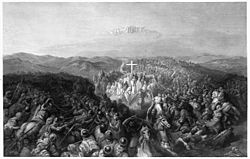
During the Crusades, Ascalon was very important. It was located on the coast, between the Crusader States and Egypt. For over 50 years, it was the last major Fatimid stronghold.
In 1099, the First Crusade captured Jerusalem. The Fatimid army retreated to Ascalon. In August, about 10,000 Crusaders marched to Ascalon. They surprised the Fatimids in the Battle of Ascalon and defeated them. However, the city itself was not captured. It remained in Fatimid hands and was used as a base to attack the Kingdom of Jerusalem.
After the Crusaders took Jerusalem, the Jewish community in Ascalon helped pay to free captured Jews. A letter from the Jewish elders of Ascalon describes their efforts.
In 1100, Ascalon and other Fatimid coastal cities paid tribute to the Crusaders for a short peace. But Ascalon remained a major Fatimid military post. It was often blocked by Crusaders on land, so supplies had to come by sea from Egypt.
Fatimid-Crusader Fights (1101 – 1153)
In July 1101, the Fatimid vizier Al-Afdal Shahanshah launched an attack from Ascalon to retake Jaffa. But Baldwin I defeated the Fatimid troops. Ascalon became even more isolated when Acre fell to the Crusaders in 1104. Still, it remained a Fatimid base. The Fatimids continued to launch small attacks from Ascalon.
In 1124, Tyre fell to the Crusaders. This made Ascalon the last Fatimid stronghold on the coast. In 1134, a Crusader count named Hugh II rebelled against King Fulk. Hugh went to Ascalon for help, and Muslim troops from Ascalon raided the nearby plains.
To deal with the threat from Ascalon, three fortresses were built around the city. These were Beth Gibelin (1135–6), Ibelin (1140), and Blanchgard (1142).
Crusader Capture and Rule (1153 – 1187)
In January 1153, Crusader King Baldwin III gathered his forces and began a siege of Ascalon. The siege lasted seven months. The city was well-prepared with strong walls and many supplies. The Fatimids managed to send over 70 ships with resources to the city during the siege.
During the siege, conflicts within the Fatimid government weakened their efforts. In July 1153, a part of the wall was breached. On August 19, the Crusaders finally took Ascalon. Many Muslims left the city after it surrendered. The Fatimids moved the head of Husayn from its shrine outside the city to their capital, Cairo.
Ascalon became a Crusader lordship. It was given to Amalric, King Baldwin III's brother. The great mosque was turned into a church, and the city became a diocese under the Patriarch of Jerusalem.
Ayyubid Destruction and Third Crusade (1187 – 1191)
Saladin, the founder of the Ayyubid dynasty, marched on Ascalon in September 1187. This was part of his conquest of the Crusader States after the Battle of Hattin. He captured the Crusader King Guy of Lusignan and the Templar Grand Master. The city surrendered after a short, fierce battle. The Christian people were sent to Alexandria and then to Europe.
In 1191, during the Third Crusade, Saladin ordered Ascalon to be destroyed. He did this because it was so important strategically. He didn't want the Crusaders to use it. Saladin reportedly said he would rather lose his children than lose Ascalon. The destruction of the city and its people is well described in Islamic writings.
In January 1192, King Richard the Lionheart of England began to rebuild Ascalon's defenses. This took four months. It became a very strong fortress. Saladin demanded its destruction in peace talks. Finally, a peace treaty was signed in Jaffa, and Ascalon's newly built defenses were destroyed again in September 1192.
Crusader Rebuilding to Final Destruction (1229 – 1270)
In 1229, Ascalon returned to Crusader hands through a peace treaty. But due to internal conflicts among the Crusaders, the city remained in ruins. In 1239, the Knights Hospitaller signed a peace agreement with the Ayyubids. The Crusaders were allowed to rebuild Ascalon's defenses. The work was completed in April 1241. Ascalon once again became one of the strongest fortresses in the Mediterranean. It had a double wall and many towers.
In 1244, the Egyptian army, led by Baybars, defeated the Hospitaller troops at Gaza. They then blocked Ascalon. The city's soldiers managed to hold out against the Egyptians. But in June 1247, the Egyptians focused all their efforts on Ascalon. The city fell on October 15, 1247. After this, the walls were again taken down.
The long history of ancient and medieval Ascalon ended in 1270. The Mamluk sultan Baybars ordered the fortress and harbor to be destroyed. This was part of a plan to destroy coastal towns. He wanted to prevent any future Crusader invasions. Some monuments, like the shrine of Sittna Khadra and the Shrine of Husayn's Head, survived. Baybars built a new town called Majdal ‘Asqalān about 3 kilometers inland. It had a large mosque, a marketplace, and religious shrines.
Archaeology
People started visiting and drawing the site of Ascalon in the 18th century. Building materials were often taken from the ruins. The first known excavation happened in 1815. Lady Hester Stanhope dug there for two weeks with 150 workers. Not many records were kept from this early dig.
From 1920 to 1922, John Garstang and W. J. Phythian-Adams led excavations. They focused on Roman and Philistine/Canaanite areas. In recent decades, more excavations have been done by the Israel Antiquities Authority.
Modern excavations began in 1985 with the Leon Levy Expedition. Lawrence Stager of Harvard University led this work until 2006. In 1991, they found a small ceramic shrine. It held a bronze statue of a bull calf, which was originally covered in silver. In 1997, a clay tablet fragment with writing was found. It listed words in both Sumerian and Canaanite languages. This was from around the 13th century BC.
Legacy
Ascalon has left its mark on history and even on our language. The words "scallion" and "shallot" both come from the name of ancient Ascalon. They are types of onions named after the city.
There is also a German song called "Im schwarzen Walfisch zu Askalon" (In the Black Whale of Ascalon). It is a traditional song sung in German universities. The lyrics were written in 1854, and the melody is even older.
See Also
- Ashkelon
Images for kids


